必修四Unit5Readingthemeparks公开课上课讲义
- 格式:ppt
- 大小:9.49 MB
- 文档页数:3
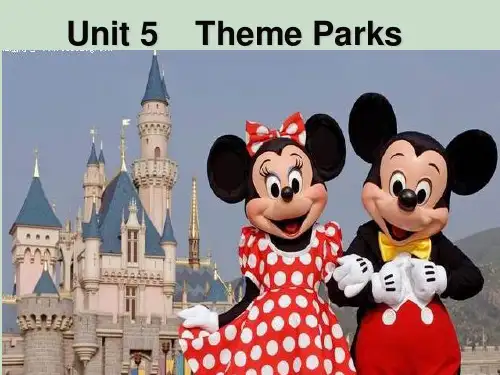


【本讲教育信息】一、教学内容必修4 Unit 5 Theme parks(一)重点单词(二)重点短语(三)重点句型二、知识精讲(一)重点单词1. various adj. 不同的;各种各样的There are various colors to choose from.这里有各种各样的颜色可供选择。
There are various ways to solve the problem.解决这个问题有许多种方法。
[知识拓展]vary vi. & vt. (使)变化, 改变,不同variety n. 变化;种类Old people don’t like to vary their habits.老年人不喜欢改变他们的习惯。
This pile of apples vary in size. 这堆苹果大小不一。
Everyone arrived late at the party for a variety of/ varieties of reasons.参加聚会的人因种种原因而迟到了。
2. whichever pron. 无论哪一个,任何一个It has been the same result whichever way you do it.不管你怎么做,结果都一样。
Take whichever you want. 你想拿哪一个,就拿哪一个。
辨析:whatever / whicheverwhichever无论哪一个,任何一个,有限定范围whatever 无论什么,无限定范围Whatever you do, I will be in favor of you.无论你做什么,我都会支持你。
Whichever of them are you going to help?你究竟要帮助他们当中的哪一个?3. attraction n. 吸引(力);吸引人的事物The idea of traveling to the moon has little attraction for me.到月球旅行的想法对我没有很大的吸引力。
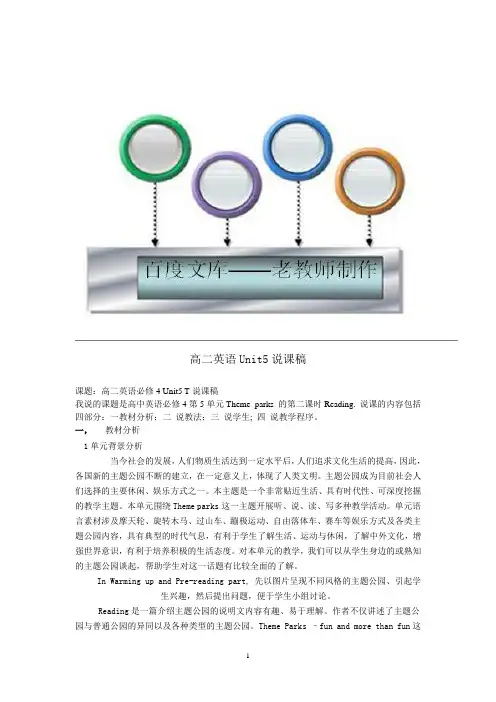
高二英语Unit5说课稿课题:高二英语必修4 Unit5 T说课稿我说的课题是高中英语必修4第5单元Theme parks 的第二课时Reading. 说课的内容包括四部分:一教材分析;二说教法;三说学生; 四说教学程序。
一,教材分析1单元背景分析当今社会的发展,人们物质生活达到一定水平后,人们追求文化生活的提高,因此,各国新的主题公园不断的建立,在一定意义上,体现了人类文明。
主题公园成为目前社会人们选择的主要休闲、娱乐方式之一。
本主题是一个非常贴近生活、具有时代性、可深度挖掘的教学主题。
本单元围绕Theme parks这一主题开展听、说、读、写多种教学活动。
单元语言素材涉及摩天轮、旋转木马、过山车、蹦极运动、自由落体车、赛车等娱乐方式及各类主题公园内容,具有典型的时代气息,有利于学生了解生活、运动与休闲,了解中外文化,增强世界意识,有利于培养积极的生活态度。
对本单元的教学,我们可以从学生身边的或熟知的主题公园谈起,帮助学生对这一话题有比较全面的了解。
In Warming up and Pre-reading part, 先以图片呈现不同风格的主题公园、引起学生兴趣,然后提出问题,便于学生小组讨论。
Reading是一篇介绍主题公园的说明文内容有趣、易于理解。
作者不仅讲述了主题公园与普通公园的异同以及各种类型的主题公园。
Theme Parks –fun and more than fun这篇主题公园指出了人们不仅可以在主题公园中使自己身心放松并得到娱乐,同时还可以从娱乐中获得知识和必要的体验。
我们引导学生了解和比较不同主题公园的特色后,激发学生联想主题公园的未来发展,鼓励学生自行设计公园的主题活动,鼓励学生积极想象、培养创新能力。
学生在本单元的学习过程和开展的小组活动中,除了增长语言知识、提高语言技能外,更要拓展文化视野,发展跨文化交际的意识和能力;并且结合个人经验充分体验他人在个别主题活动方面的感受,加强合作意识、陶冶情操,提高自身素养。

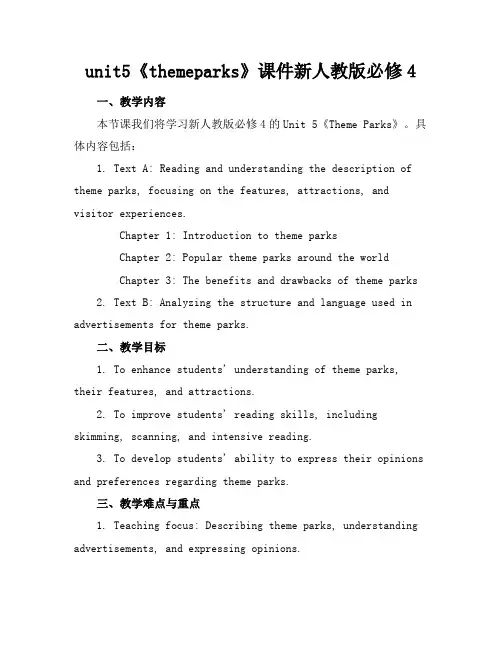
unit5《themeparks》课件新人教版必修4一、教学内容本节课我们将学习新人教版必修4的Unit 5《Theme Parks》。
具体内容包括:1. Text A: Reading and understanding the description of theme parks, focusing on the features, attractions, and visitor experiences.Chapter 1: Introduction to theme parksChapter 2: Popular theme parks around the worldChapter 3: The benefits and drawbacks of theme parks2. Text B: Analyzing the structure and language used in advertisements for theme parks.二、教学目标1. To enhance students' understanding of theme parks, their features, and attractions.2. To improve students' reading skills, including skimming, scanning, and intensive reading.3. To develop students' ability to express their opinions and preferences regarding theme parks.三、教学难点与重点1. Teaching focus: Describing theme parks, understanding advertisements, and expressing opinions.2. Teaching difficulties: Mastering the vocabulary related to theme parks and using appropriate language to express preferences.四、教具与学具准备1. Teaching materials: PowerPoint slides, handouts with vocabulary lists, reading texts.2. Learning materials: Notebooks, dictionaries, and textbooks.五、教学过程1. Introduction (5 minutes):Present a reallife scenario: Imagine planning a trip to a theme park.Engage students in a brief discussion about their experiences and favorite theme parks.2. Reading Text A (15 minutes):a. Skimming: Students quickly read the text to grasp the main idea.b. Scanning: Students find specific information about theme park features and attractions.c. Intensive reading: Analyze the structure and language used in the text.3. Vocabulary Practice (10 minutes):Present new vocabulary related to theme parks.Conduct interactive activities to reinforce vocabulary understanding.4. Reading Text B (15 minutes):Analyze the structure and persuasive language used in theme park advertisements.Discuss the benefits and drawbacks mentioned in the advertisements.5. Group Discussion (10 minutes):Divide students into groups and ask them to discuss their opinions on theme parks.Encourage them to use the vocabulary learned during the discussion.6. Presentation (10 minutes):Each group presents their opinions, supported reasons and examples from the texts.六、板书设计1. Main headings: "Features of Theme Parks," "Popular Theme Parks," "Advertisements," "Opinions and Preferences."2. Key vocabulary: List important words and phrases related to theme parks.3. Structured notes: Outline the structure of the texts and advertisements.七、作业设计1. Comprehension Questions:What are the main features of theme parks?How do advertisements persuade visitors to visittheme parks?2. Essay Writing:Write an essay expressing your opinion on theme parks, including reasons and examples.(Answer Key: Provided with detailed feedback on content, organization, and language use.)八、课后反思及拓展延伸1. Reflection: Assess students' engagement, understanding, and participation during the lesson. Identify areas for improvement.2. Extension: Encourage students to research a specific theme park and create their own advertisement, incorporating persuasive language and highlighting unique features. Present these advertisements in the next class for peer evaluationand discussion.重点和难点解析1. 教学目标中的阅读技能提升2. 教学难点:主题公园相关词汇的掌握和表达偏好3. 教学过程中阅读策略的应用4. 作业设计中的论述题写作一、教学目标中的阅读技能提升1. Skimming(快速阅读):学生通过快速阅读,抓住文章的主旨大意。
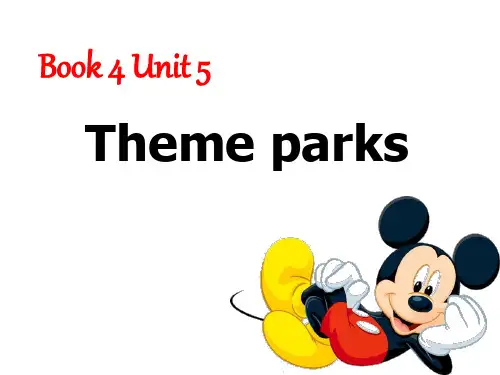
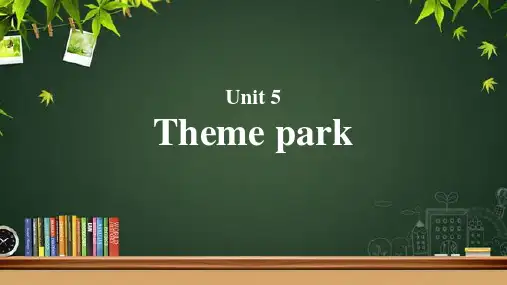

中学英语必修4 Unit5 Theme parks说课稿高二英语Unit5说课稿Place: Multimedia classroom课题:高二英语必修4 Unit5 T说课稿我说的课题是中学英语必修4第5单元Theme parks 的其次课时Reading. 说课的内容包括四部分:一教材分析;二说教法;三说学生; 四说教学程序。
一,教材分析1单元背景分析当今社会的发展,人们物质生活达到肯定水平后,人们追求文化生活的提高,因此,各国新的主题公园不断的建立,在肯定意义上,体现了人类文明。
主题公园成为目前社会人们选择的主要休闲、消遣方式之一。
本主题是一个特别贴近生活、具有时代性、可深度挖掘的教学主题。
本单元围绕Theme parks这一主题开展听、说、读、写多种教学活动。
单元语言素材涉及摩天轮、旋转木马、过山车、蹦极运动、自由落体车、赛车等消遣方式及各类主题公园内容,具有典型的时代气息,有利于学生了解生活、运动与休闲,了解中外文化,增加世界意识,有利于培育主动的生活看法。
对本单元的教学,我们可以从学生身边的或熟知的主题公园谈起,帮助学生对这一话题有比较全面的了解。
In Warming up and Pre-reading part, 先以图片呈现不同风格的主题公园、引起学生爱好,然后提出问题,便于学生小组探讨。
Reading是一篇介绍主题公园的说明文内容好玩、易于理解。
作者不仅讲解并描述了主题公园与一般公园的异同以及各种类型的主题公园。
Theme Parks –fun and more than fun这篇主题公园指出了人们不仅可以在主题公园中使自己身心放松并得到消遣,同时还可以从消遣中获得学问和必要的体验。
我们引导学生了解和比较不同主题公园的特色后,激发学生联想主题公园的将来发展,激励学生自行设计公园的主题活动,激励学生主动想象、培育创新实力。
学生在本单元的学习过程和开展的小组活动中,除了增长语言学问、提高语言技能外,更要拓展文化视野,发展跨文化交际的意识和实力;并且结合个人阅历充分体验他人在个别主题活动方面的感受,加强合作意识、陶冶情操,提高自身素养。
![高一英语人教课标必修4 Unit 5 Theme Parks Reading[] PPT课件 图文](https://uimg.taocdn.com/d49c3551cc7931b764ce1520.webp)
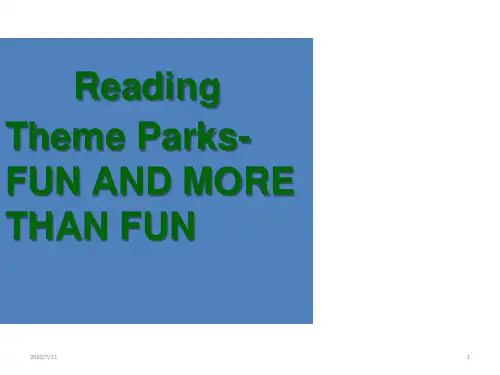
2024年公开课unit5themeparks经典完整课件一、教学内容本节课我们将学习《2024年公开课》Unit 5 "Theme Parks" 的相关内容。
主要涉及教材第二章 "Entertainment and Leisure",具体内容包括主题公园的定义、特点、分类以及著名主题公园的介绍。
二、教学目标1. 了解主题公园的定义、特点及分类。
2. 学会介绍著名主题公园及其特色。
3. 提高学生的听说读写综合运用能力。
三、教学难点与重点重点:主题公园的定义、特点、分类以及著名主题公园的介绍。
难点:如何运用所学知识进行实际情景的口语表达。
四、教具与学具准备教具:PPT、录音机、磁带学具:课本、笔记本、词典五、教学过程1. 导入(5分钟)通过展示一组著名主题公园的图片,引导学生进行讨论,激发学生的兴趣。
2. 新课内容呈现(15分钟)通过PPT展示,讲解主题公园的定义、特点及分类。
播放录音,让学生跟读并模仿。
3. 情景对话(10分钟)创设情境,让学生分组进行角色扮演,模拟在主题公园的对话。
4. 例题讲解(15分钟)通过讲解典型例题,帮助学生巩固所学知识。
5. 随堂练习(10分钟)设计相关练习题,让学生进行随堂练习,检验学习效果。
6. 小组讨论(10分钟)让学生分组讨论自己最喜欢的主题公园及原因。
六、板书设计1. Unit 5 Theme Parks2. 主要内容:定义、特点、分类著名主题公园介绍口语表达技巧七、作业设计1. 作业题目:Write a short essay about your favorite theme park.Answer the following questions about the lesson.2. 答案:略八、课后反思及拓展延伸1. 教师反思:关注学生在课堂上的参与度,及时调整教学方法,提高教学效果。
2. 学生拓展:鼓励学生在课后了解更多关于主题公园的知识,提高英语实际运用能力。